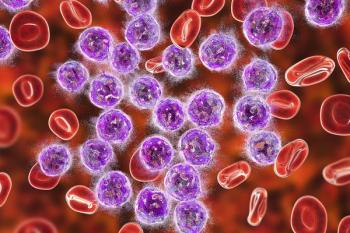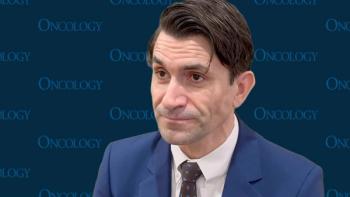
Oncology NEWS International
- Oncology NEWS International Vol 9 No 5
- Volume 9
- Issue 5
HCVAD/Transplant Promising for Mantle Cell Lymphoma
NEW ORLEANS-The chemotherapy regimen HCVAD followed by stem cell transplantation yields high response and survival rates for patients with aggressive mantle cell lymphoma, Issa Khouri, MD, of the M.D. Anderson Cancer Center, reported at the 41st annual meeting of the American Society of Hematology (ASH).
NEW ORLEANS-The chemotherapy regimen HCVAD followed by stem cell transplantation yields high response and survival rates for patients with aggressive mantle cell lymphoma, Issa Khouri, MD, of the M.D. Anderson Cancer Center, reported at the 41st annual meeting of the American Society of Hematology (ASH).
The study involved 37 patients with poor-risk mantle cell lymphoma who had not been previously treated.
HCVAD was administered according to the following schedule:
Cyclophosphamide at 300 mg/m² every 12 hours for six doses with mesna (Mesnex).
Vincristine 2 mg administered intravenously 12 hours after the last cyclophosphamide dose and again on day 11.
Dexamethasone 40 mg/d on days 1 to 4 and 11 to 14.
Adriamycin 50 mg/m² continuous infusion on days 4 and 5.
After a cycle of HCVAD, each patient then received a cycle of methotrexate at 1 g/m² over 24 hours on day 1 with leucovorin rescue and cytarabine at 3 g/m² every 12 hours, for a total of four doses on days 2 and 3. The patients then went through one more round of HCVAD followed by methotrexate and cytarabine.
Of the 37 patients, seven did not undergo transplant, five because of patient preference or insurance difficulties, one because of disease progression, and one who died during the HCVAD treatment.
Of those who received a stem cell transplant, 4 patients had an allogeneic transplant, and 26 an autologous transplant. The type of transplant depended on the patient’s age and whether a suitable related donor was available. One patient died as a result of stem cell transplant.
Study Results
Eighteen patients (49%) had a partial remission, and 17 (46%) a complete remission. All patients who had a stem cell transplant and survived had a complete remission, although 3 patients relapsed after a median follow-up of 34 months. The researchers project that 4-year survival will be 90%.
Articles in this issue
over 25 years ago
HRT Not Associated with Lower Survival After Breast Cancerover 25 years ago
Age No Contraindication to High-Dose Therapy in Myelomaover 25 years ago
ASCO Urges Passage of Patient’s Bill of Rightsover 25 years ago
RT Not Necessarily an Impedance to Breast Reconstructionover 25 years ago
New Adjunctive Regimens for Breast Cancer Treatment Are Under Studyover 25 years ago
NCCN Prostate Cancer Practice Guidelines Revisedover 25 years ago
ERT Does Not Increase Endometrial Cancer Recurrenceover 25 years ago
Radiochemotherapy/Transplant in Low-Grade Lymphomasover 25 years ago
Fish Oil Supplements May Improve Cancer Therapies’ Effectivenessover 25 years ago
Study of Dying Cancer Patients Reveals Importance of RitualsNewsletter
Stay up to date on recent advances in the multidisciplinary approach to cancer.





